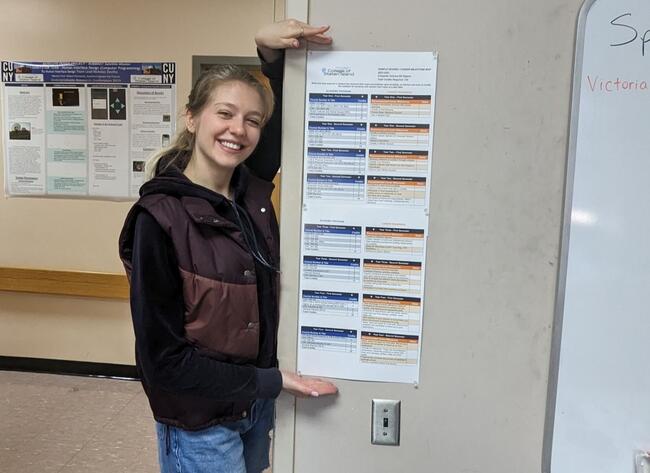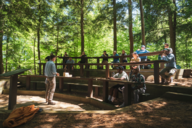You have /5 articles left.
Sign up for a free account or log in.

Victoria Jaczynski (’23) holds up a copy of the career-infused degree map. The map outlines academic and career-readiness benchmarks students should complete throughout their time in the computer science program.
Kristi Brescia/College of Staten Island, CUNY
Forty percent of college students believe that encouraging professors to help them better connect what they’re learning in class to issues outside the classroom or career goals would improve their academic success, according to a May 2024 Student Voice survey by Inside Higher Ed and Generation Lab.
A similar number (38 percent) of respondents also want their institution to prioritize helping students prepare for internship and career success, out of a list of 13 career-focused interventions.
Kristi Brescia, academic career manager at the City University of New York’s College of Staten Island, saw firsthand that students didn’t always understand the relationship between their required courses and their overall career goals.
“We needed a way to make the connection between academics and career preparation visible, intentional and actionable from the start,” she said.
To highlight that link, the college created a Career-Infused Degree Map in the computer science department. In addition to outlining academic program requirements, the map includes a checklist of career-readiness markers that students should achieve during the academic term.
The background: When Brescia joined the College of Staten Island in 2020, she would ask the upper-level computer science students she advised what tasks they had completed to prepare for an internship, such as creating a résumé or working with practice problems.
Often, students were taken aback.
“I would say that 97 percent were not prepared for an interview or an internship,” Brescia said. “Rather, they were very shocked at what they were supposed to do. They just kept saying, ‘Nobody ever told me. Why wasn’t this brought up to me? Who was supposed to tell me? When was I supposed to do this?’”
Brescia realized that despite all the time students spent talking to advisers, utilizing career center services and learning in the classroom, they were still unprepared for the next step in their career journey. To close this gap, she created a degree map that aligned career-readiness steps with a suggested course sequence.
How it works: The map is broken into academic terms and details the courses students should complete, as well as some opportunities for career engagement.
For example, during their first semester of year one, students are encouraged to create a Handshake account, join a student club or start building a basic résumé. In the first semester of their second year, students are encouraged to identify a mentor, attend a professional development workshop and research internship opportunities.
“The goal was simple: remove guesswork and ensure every student leaves not just with a degree, but with tangible career readiness,” Brescia said.
Many career services offices have their own student journey maps, but often they focus more on career exploration or strengths assessments. The career-infused map is a department-specific resource that identifies how one major can lead to a variety of careers, Brescia explained.
To identify relevant and appropriate career steps, Brescia met with industry partners, faculty members, career advisers, students and recent graduates of the computer science program to solicit ideas and determine which steps best matched with a student’s academic journey.
The impact: Now, a variety of campus partners engage with and share information from the map, creating a common language and a range of touch points for students to receive encouragement.
Staff and faculty advisers use the resource during advising appointments, and some professors integrate elements from the map into their course requirements.
Students also run with it, taking the initiative to complete as many of the listed tasks as possible to set themselves up for success, Brescia said.
In addition to breaking departmental silos, the map helps level the playing field. Some student populations, such as first-generation learners, have found it particularly beneficial because it clarifies some elements of the hidden curriculum and creates transparent expectations for career preparation throughout their academic journeys, Brescia said.
One example: Two recent alumni from the computer science division were hired for the same role at a software engineering company. One was a Macaulay Honors College student and the other an adult learner with two young children. Despite their varying access to support resources and assistance programs, both were able to land high-paying jobs and succeed after college, due in part to their use of the map.
Between 2021 and 2024, career outcomes flourished, with 43 percent more computer science students participating in internships and a 144 percent increase in the number of students landing a full-time job upon graduation, according to college data. Students’ starting salaries also increased 34 percent, compared to previous baselines.
Scaling up: The initiative caught the eye of system leaders, and in 2024, CUNY received a $700,000 grant from the Robin Hood Foundation to implement career-infused degree maps across all CUNY campuses. Brescia has worked as an advising consultant with the system office, assisting with development of a guidebook and offering best practices in creating the map.
To date, 50 academic departments across 17 campuses have made the shift, impacting 25,000 students enrolled in those programs.
Engaging across the system has been a challenge in part because each institution has its own culture, leadership and advising structures, Brescia said. But the impact is clear, and making the change requires only time and collaboration.
“I did it at my kitchen table,” Brescia said. “It was myself, faculty, students and alumni, just working together. And now CUNY has taken that to another level … It’s incredibly rewarding to know that we did it in my little office here at the College of Staten Island, and that [the system] sees the benefit of it and they see the results.”
Do you have an academic intervention that might help others improve student success? Tell us about it.



